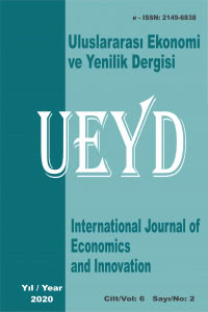Türki Cumhuriyetlerde Elektrik Tüketimi, Reel Gelir ve Dışa Açıklık İlişkisi: Bootstrap-Granger Nedensellik Yaklaşımı
Bu çalışma, Türki Cumhuriyetlerde gelir, elektrik enerji tüketimi ve dışa açıklık, arasındaki nedensellik ilişkilerini, yatay-kesit bağımlılığı dikkate ikinci nesil panel veri yöntemleri kullanılarak 1992-2012 dönemi için araştırmaktadır. Yatay kesit bağımlılık test sonuçlarına göre, tüm değişkenler ve model yatay kesit bağımlıdır. Smith vd. Bootstrap (2004) birim kök testi sonuçlarına göre kişi başı gelir ve dışa açıklık değişkenleri düzeyde, elektrik tüketimi değişkeni ise fark durağandır. Bu nedenle değişkenler arasında uzun dönemli ilişkilerin varlığını test etmeye yönelik olarak eşbütünleşme testleri uygulanmamıştır. Değişkenler arasındaki nedensel ilişkiler, yatay kesit bağımlılığı dikkate alan, ülke bazlı sonuçlar elde etmeye olanak sağlayan ve iki açıklayıcı değişkenin bağımlı değişken üzerindeki etkisini aynı anda test etmeye olanak sağlayan Konya (2006) panel nedensellik modeliyle incelenmiştir. Analiz sonuçları şu şekilde özetlenebilir: i) Elektrik tüketimi ve gelir arasında nedensellik ilişkisi mevcuttur. ii) Dışa açıklık ve gelir arasında nedensellik ilişkisi mevcuttur. iii) Enerji tüketimi ve dışa açıklık değişkenleri, gelir üzerinde daha güçlü ortak etkiye sahiptir.
Anahtar Kelimeler:
Enerji, Elektrik Tüketimi, Dışa Açıklık, Panel Veri
The Relationship between Electricity Consumption, Real Income and Trade Openness in Turkic Republics: Bootstrap-Granger Causality Approach
This study explores the causal relationships between electricity consumption, real income and trade openness in Turkic Republics for 1992-2012 period by using second generation panel data methods under cross-sectional dependence. According to cross-sectional dependence tests, all variables and model are cross-sectionally dependent. According to the Smith et al. (2004) bootstrap unit root test, real income per capita and trade openness variables are stationary on level. On the contrary, electricity consumption variable is stationary in first difference. Therefore, cointegration tests have not been implemented in order to long-run relationships between variables. Causal relationships between variables have been examined by using Konya (2006) panel data causality approach which allows cross-sectional dependence and gives possibility to examine two explanatory variables’ effects on dependent variable and obtain country-specific results. The results can be summarized as follows: i) There exist a causal relationship between electricity consumption and real income. ii) There exist a causal relationship between trade openness and real income. iii) Electricity consumption and trade openness variables have more powerful common effects on real income.
Keywords:
Energy, Electricity Consumption, Trade Openness,
___
- Acaravci, A. (2010), Structural breaks, electricity consumption and economic growth: Evidence from Turkey. Journal for Economic Forecasting, 2, 140-154.
- Acaravci, A., Ozturk, I. (2012), Electricity consumption and economic growth nexus: A multivariate analysis for Turkey. Amfiteatru Economic, 14(31), 246-257.
- Acaravcı, A., Erdoğan, S. & Akalin G. (2015). The Electricity Consumption, Real Income, Trade Openness and Foreign Direct Investment: The Empirical Evidence from Turkey. International Journal of Energy Economics and Policy, 5 (4), 1050-1057.
- Aktas, C., Yilmaz, V. (2008), Causal relationship between electricity consumption and economic growth in Turkey. Zonguldak Karaelmas Üniversitesi Sosyal Bilimler Dergisi, 4(8), 45-54.
- Altinay, G., Karagol, E. (2005), Electricity consumption and economic growth: Evidence from Turkey. Energy Economics, 27(6), 849-856.
- Aslan, A. (2013), Causality between electricity consumption and economic growth in Turkey: An ARDL bounds testing approach. Energy Sources Part B: Econ Plan Policy, 9(1), 25-31.
- Aslan, A. (2014), Electricity consumption, labor force and GDP in Turkey: Evidence from multivariate Granger causality. Energy Sources, Part B: Economics, Planning, and Policy, 2, 174-182.
- Dünya Bankası, Dünya Gelişme Göstergeleri Çevrimiçi Veri Tabanı (World Bank World Development Indicators Online Database, http://databank.worldbank.org/data/views/variableSelection/selectvariables.aspx?source=world-development-indicators#) (Erişim Tarihi: 10.12.2015).
- Erbaykal, E. (2008), Disaggregate energy consumption and economic growth: Evidence from Turkey. International Research Journal of Finance and Economics, 20, 1-8.
- Jumbe, C.B.L. (2004), Cointegration and causality between electricity consumption and GDP: Empirical evidence from Malawi. Energy Economics, 26(1), 61-68.
- Konya, L. (2006). Export and growth: Granger causality analyisis on OECD countries with a panel data approach. Economic Modelling, 23, 978-992.
- Kraft, J., Kraft, A. (1978), On the relationship between energy and GNP. Journal of Energy and Development, 3, 401-403.
- Ibrahiem, D. M. (2015). Renewable electricity consumption, foreign direct investment and economic growth in Egypt: An ARDL approach. Procedia Economics and Finance 30, 313-323.
- International Monetary Fund (2000). Transitition Economies: An IMF Perspective on Progress and Prospects. http://www.imf.org/external/np/exr/ib/2000/110300.htm (Erişim Tarihi 05.10.2016).
- Iyke, B. N. (2015). Electricty consumption and economic growth in Nigeria: A revisit of the energy-growth debate. Energy Economics, 51, 166-176.
- Murray, D.A., Nan, G.D. (1996), A definition of the gross domestic product electrification interrelationship. Journal of Energy and Development, 19, 275-283.
- Narayan, P.K., Prasad, A. (2008), Electricity consumption–real GDP causality nexus: Evidence from a bootstrapped causality test for 30 OECD countries. Energy Policy, 36(2), 910-918.
- Nazlioglu, S., Kayhan, S., Adiguzel, U. (2014), Electricity consumption and economic growth inTurkey: Cointegration, linear and nonlinear granger causality. Energy Sources Part B: Econ Plan Policy, 9(4), 315-324.
- Pesaran, M. Hasheem (2004). “General Diagnostic Tests for Cross Section Dependence in Panels”. http://www.econ.cam.ac.uk/research/repec/cam/pdf/cwpe0435.pdf (Erişim Tarihi: 01.12.2015).
- Pesaran, M. Hasheem; Yamagata, Takashi (2008). “Testing Slope Homogenity in Large Panels”. Journal of Econometrics, 142; 50-98.
- Pempetzoglou, M. (2014), Electricity consumption and economic growth: A linear and nonlinear causality investigation for Turkey. International Journal of Energy Economics and Policy, 4(2), 263-273.
- Salahuddin, M. & Alam K. (2016). Information and Communication Technology, electricity consumption, and economic growth in OECD countries: A panel data analysis. Electrical Power and Energy Systems, 76, 185-193.
- Smith, L. Vanessa; Leybourne, Stephen; Kim, Tae-Hwan; Newbold, Paul (2004). More Powerful Panel Data Unit Root Tests with an Application to Mean Reversion in Real Exchange Rates. Journal of Applied Econometrics, 19; 147-170
- Soytas, U., Sari, R. (2007), The relationship between energy and production: Evidence from Turkish manufacturing industry. Energy Economics, 29, 1151-1165.
- ISSN: 2149-6838
- Yayın Aralığı: Yılda 2 Sayı
- Başlangıç: 2015
- Yayıncı: Seyfettin Artan
Sayıdaki Diğer Makaleler
Türk İmalat Sanayinde İhracat ve İnovasyon Arasındaki İlişki
Aykut Karakaya, Seymur Ağazade, Selçuk Perçin
Kaynak Tabanlı Görüşten Dinamik Yeteneklere Tarihsel Bir İnceleme
Mali Disiplin Ve Enflasyon İlişkisi Üzerine Bir Analiz: Türkiye Örneği
